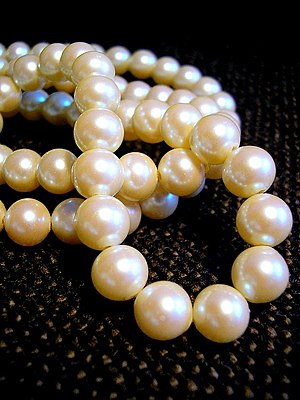The highest quality cultured pearl necklaces are made and created Mikimoto. These pearls are known for their unique beauty and shine. It is said that when using Mikimoto pearls, any other kind of pearls seems secondary. Mikimoto pearls are so refined in quality that its fans include the royal family in Britain and Japan, Marilyn Monroe and Princess Grace of Monaco.
Here is some information about what Mikimoto cultured pearls are, where they came from and how they buy.
If the beads formed
Pearl is the result of mollusk or oyster "reaction to an irritant that affects the skull. Trying to protect themselves, mollusk excludes crystalline substance called nacre which builds up in layer after layer that surrounds the irritant. When this happens, the pearl is born.
Pearls have been grown for centuries not only in Japan but also in other countries. Much of the product result for semispherical pearls, also called mabe pearls from the oyster that grew them, and not in the more coveted spherical pearls. It was Kokichi Mikimoto developed a special technique cause oysters to create a round pearl.
The man behind the name
Cultured pearls, as we know it owes much of Kokichi Mikimoto, the man who perfected the cultivation of pearls method is still used today. Contrary to popular belief, that although he did not invent the industry played an important role in promoting the technology, which helped to improve the quality of pearls.
Mikimoto, the son of noodle restaurant owner, was born in 1885 in Toba City, Japan. He was first introduced to the beads, when he began to make oysters. Around this time, Japan was already trading with other countries, pearls and pearl oysters were in danger of being over-harvested. Mikimoto decided to focus on experiments in the production of seed oysters and pearls.
The first concrete steps have been failures. Mikimoto and his colleagues repeatedly encountered disappointing results are partly due to uncontrollable factors like water temperature and red tides. But it does nothing to dissuade Mikimoto from his dream.
His efforts have borne fruit in the finish. On 11 07th 1893, along with his wife Ume, he discovered a beautiful gem in one of his oysters. Never looked back since. By the time he died in 1954, honored Mikimoto had successfully advocated and promoted cultured and open markets around the world. Today his name is synonymous with the highest quality cultured pearls.
Buy Mikimoto pearl necklace
Beads Chains come in several lengths. From shortest to longest, are: collar (10 "-13"), collar (14 "-16"), Princess (18 "-20"), afternoon (20 "-24"), opera (28 "- 34" ) and cables (37 "and larger). length pearl necklace will depend on the woman's age, body composition and neck size, but 18 to 24 inches pearl necklace is a good time for anyone. Generally, the longer the necklace more" extensions " in the neck.
The symbol "M"
Each jewelry created by Mikimoto including pearl necklaces, the "M" engraved on its settings. This is a guarantee of quality. But in some cases, the designation "M" to ensure that the setting is real, and not the gems that can be replaced and restrung.
Warning: there is a black market for Mikimoto clasps, where original Mikimoto clasps are used for cheaper or imitation pearls quality. Watch out also for "The closure Mikimoto sales, although they come in the" new "18k gold.
The best way to distinguish real quality Mikimoto pearl from other pearls looking for a unique plan or lines on the surface under 10x magnifying glass beads. Experienced jewelers can recognize. On your own, you'll want to find genuine Mikimoto pearls compared with the intended purchase. When you see the difference, true Mikimoto pearls are easily recognizable.
You may also encounter pearl necklaces that are labeled 'Mikimoto quality ". This is misleading. These are not pearls produced under the patented Mikimoto process. True Mikimoto pearl necklaces are manufactured under strict conditions in Ise in Honshu, Japan.
Mikimoto Akoya vs
Other pearls are fine quality Akoya pearls, even though it is a general term used to refer to sea pearls. This is not a Mikimoto beads and costs are not the same.
Method of marking
Mikimoto pearls are evaluated using four classes, with AAA being the highest. There are four sub-AAA1 quality starts. The highest quality pearls are the ones with the best luster and reflective quality, almost glassy, while lower quality pearls are those with relatively clear reflection.
When buying a Mikimoto pearl necklace, be sure to ask for grading certificates. It's not only good for insurance, but is also a guarantee that what you pay for is true Mikimoto pearl necklace.

